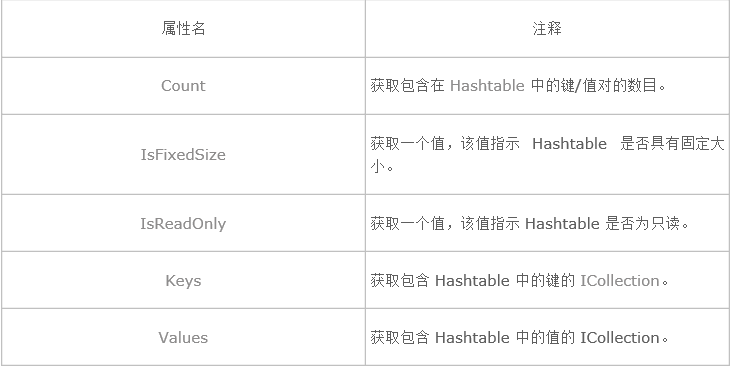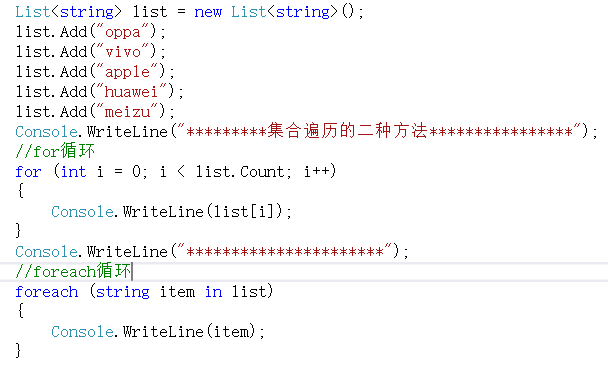原文链接:https://www.cnblogs.com/sujulin/p/7137938.html
集合:将一推数据类型相同的数据放入到一个容器内,该容器就是数组:内存中开辟的一连串空间。
非泛型集合
ArrayList集合:
ArrayList是基于数组实现的,是一个动态数组,其容量能自动 增长
ArrayList的命名空间System.Collections
常用方法如下:



示例
static void Main(string[] args)
{
ArrayList list = new ArrayList();
//添加单个元素
list.Add(true);
list.Add(1);
list.Add("张三");
//添加集合元素
list.AddRange(new int[] { 1, 2, 3, 4, 5, 6, 7, 8, 9 });
//list.AddRange(list);
//list.Clear();清空所有元素
//list.Remove(true);删除单个元素 写谁就删出谁
//list.RemoveAt(0);根据下标去删除元素
//list.RemoveRange(0, 3);根据下标去移除一定范围的元素
//list.Insert(1, "插入的");在指定的位置插入一个元素
//list.InsertRange(0, new string[] { "张三", "李四" });在指定的位置插入一个集合
//bool b = list.Contains(1);判断是否包含某个指定的元素
list.Add("大男孩");
if (!list.Contains("大男孩"))
{
list.Add("大男孩");
}else{
Console.WriteLine("已经有了");
}<br> //循环打印
for (int i = 0; i < list.Count; i++)
{
Console.WriteLine(list[i]);
}
// list.Sort();//升序排列
//list.Reverse();反转
Console.ReadKey();
}
ArrayList集合遍历的三种方式:
foreach(Object item in list){
Console.writer(item.ToString()+"");
}
Ienumertor num=list.GetEnumertor();
while(num.MoveNext()){
Console.writer(num.Curret.ToString()+"");
}
for(int i=0;i<list.count;i++){
Console.Writer(list[i].ToString()+"");
}
HashTable集合:
HashTable的常用属性和方法:


示例:
//创建一个HashTable
Hashtable openWith = new Hashtable();
//为HashTable添加元素,不能有重复的key,但可以有重复的值
openWith.Add("txt", "notepad.exe");
openWith.Add("bmp", "paint.exe");
openWith.Add("dib", "paint.exe");
openWith.Add("rtf", "wordpad.exe");
//通过key获得值
Console.WriteLine("For key = \"rtf\", value = {0}.", openWith["rtf"]);
//重新赋值
openWith["rtf"] = "winword.exe";
Console.WriteLine("For key = \"rtf\", value = {0}.", openWith["rtf"]);
//判断是否包含特定的key
if (!openWith.ContainsKey("ht"))
{
openWith.Add("ht", "hypertrm.exe");
Console.WriteLine("Value added for key = \"ht\": {0}", openWith["ht"]);
}
HashTable集合遍历的方式:

泛型集合
List<T>集合:
特点:
1)、可通过索引访问的对象的强类型。
2)、是ArrayList类的泛型等效类。
3)、可以使用一个整数索引访问此集合中的元素;索引从 零开始。
4)、可以接收null空引用(VB中的Nothing)。
5)、允许重复元素。
List<T>集合的方法:
01. Add 将对象添加到 List<T> 的结尾处。
02. AddRange 将指定集合的元素添加到 List<T> 的末尾。
03. AsReadOnly 返回当前集合的只读 IList<T> 包装。
04. BinarySearch(T) 使用默认的比较器在整个已排序的 List<T> 中搜索元素,并返回该元素从零开始的索引。
05. BinarySearch(T, IComparer<T>) 使用指定的比较器在整个已排序的 List<T> 中搜索元素,并返回该元素从零开始的索引。
06 . BinarySearch(Int32, Int32, T, IComparer<T>) 使用指定的比较器在已排序 List<T> 的某个元素范围中搜索元素,并返回该元素从零开始的索引。
07. Clear 从 List<T> 中移除所有元素。
08. Contains 确定某元素是否在 List<T> 中。
09. ConvertAll<TOutput> 将当前 List<T> 中的元素转换为另一种类型,并返回包含转换后的元素的列表。
10. CopyTo(T[]) 将整个 List<T> 复制到兼容的一维数组中,从目标数组的开头开始放置。
11. Exists 确定 List<T> 是否包含与指定谓词所定义的条件相匹配的元素。
12. Find 搜索与指定谓词所定义的条件相匹配的元素,并返回整个 List<T> 中的第一个匹配 元素。
13 .FindIndex(Predicate<T>) 搜索与指定谓词所定义的条件相匹配的元素,并返回整个List <T> 中第一个匹配元素的从零开始的索引。
14. ForEach 对 List<T> 的每个元素执行指定操作。 GetEnumerator 返回循环访问 List<T> 的枚举器。
15 . IndexOf(T) 搜索指定的对象,并返回整个 List<T> 中第一个匹配项的从零开始的索引。
16. Insert 将元素插入 List<T> 的指定索引处。
17. InsertRange 将集合中的某个元素插入 List<T> 的指定索引处。
18. LastIndexOf(T) 搜索指定的对象,并返回整个 List<T> 中最后一个匹配项的从零开始的索引。
19. Remove 从 List<T> 中移除特定对象的第一个匹配项。
20. Reverse() 将整个 List<T> 中元素的顺序反转。
21. Sort() 使用默认比较器对整个 List<T> 中的元素进行排序。

List<T>集合遍历的二种方法:

Dictionary<K,V>集合:
常用的方法和属性:
特点:
从一组键(Key)到一组值(Value)的映射,每一个添加项都是由一个值及其相关连的键组成
-
任何键都必须是唯一的
键不能为空引用null(VB中的Nothing),若值为引用类型,则可以为空值
Key和Value可以是任何类型(string,int,custom class 等)
-
Comparer: 获取用于确定字典中的键是否相等的 IEqualityComparer。
Count: 获取包含在 Dictionary中的键/值对的数目。
Item: 获取或设置与指定的键相关联的值。
Keys: 获取包含 Dictionary中的键的集合。
Values: 获取包含 Dictionary中的值的集合。
Add: 将指定的键和值添加到字典中。
Clear: 从 Dictionary中移除所有的键和值。
ContainsKey: 确定 Dictionary是否包含指定的键。
ContainsValue: 确定 Dictionary是否包含特定值。
GetEnumerator: 返回循环访问 Dictionary的枚举数。
GetType: 获取当前实例的 Type。 (从 Object 继承。)
Remove: 从 Dictionary中移除所指定的键的值。
ToString: 返回表示当前 Object的 String。 (从 Object 继承。)
TryGetValue: 获取与指定的键相关联的值。
-
创建及初始化
Dictionary<int,string>myDictionary=newDictionary<int,string>();
添加元素
myDictionary.Add(1,"C#");
myDictionary.Add(2,"C++");
myDictionary.Add(3,"ASP.NET");

myDictionary.Add(4,"MVC");
-
通过Key查找元素
if(myDictionary.ContainsKey(1))
 {
{Console.WriteLine("Key:{0},Value:{1}","1", myDictionary[1]);
}
通过Remove方法移除指定的键值
myDictionary.Remove(1);
if(myDictionary.ContainsKey(1))
 ...{
...{Console.WriteLine("Key:{0},Value:{1}","1", myDictionary[1]);
}
else
{
Console.WriteLine("不存在 Key : 1");
}
Dictionary<T>集合遍历的方式:
-
通过KeyValuePair遍历元素
foreach(KeyValuePair<int,string>kvp in myDictionary)
 ...{
...{Console.WriteLine("Key = {0}, Value = {1}",kvp.Key, kvp.Value);
}
仅遍历键 Keys 属性
Dictionary<int,string>.KeyCollection keyCol=myDictionary.Keys;
foreach(intkeyinkeyCol)
 ...{
...{Console.WriteLine("Key = {0}", key);
}
仅遍历值 Valus属性
Dictionary<int,string>.ValueCollection valueCol=myDictionary.Values;
foreach(stringvalueinvalueCol)
 ...{
...{Console.WriteLine("Value = {0}", value);
}
1)、Dictionary<K,V> students=new Dictionary<K,V>(); 其中“K”为占位符,具体定义时用存储键“Key”的数据类型代替,“V”也是占位符,用元素的值“Value”的数据类型代替,这样就在定义该集合时,声明了存储元素的键和值的数据类型,保证了类型的安全性。
2)、Dictionary<K,V>中元素的操作方法与HashTable相似,添加元素,获取元素,删除元素,遍历集合元素的方法基本相同。
3)、Dictionary<K,V>和HashTable的区别 Dictionary<K,V>和HashTable的相同点: 添加元素,删除元素,通过键访问值的方法相同。
Dictionary<K,V>和HashTable的不同点: Dictionary<K,V>对添加的元素具有类型约束,HashTable可添加任意类型的元素。
Dictionary<K,V>不需要装箱、拆箱操作,HashTable添加时装箱,读取时拆箱。
ArrayList与List<T>的区别:

HashTable与Dictionary<K,T>的区别:

集合:将一推数据类型相同的数据放入到一个容器内,该容器就是数组:内存中开辟的一连串空间。
非泛型集合
ArrayList集合:
ArrayList是基于数组实现的,是一个动态数组,其容量能自动 增长
ArrayList的命名空间System.Collections
常用方法如下:



示例
static void Main(string[] args)
{
ArrayList list = new ArrayList();
//添加单个元素
list.Add(true);
list.Add(1);
list.Add("张三");
//添加集合元素
list.AddRange(new int[] { 1, 2, 3, 4, 5, 6, 7, 8, 9 });
//list.AddRange(list);
//list.Clear();清空所有元素
//list.Remove(true);删除单个元素 写谁就删出谁
//list.RemoveAt(0);根据下标去删除元素
//list.RemoveRange(0, 3);根据下标去移除一定范围的元素
//list.Insert(1, "插入的");在指定的位置插入一个元素
//list.InsertRange(0, new string[] { "张三", "李四" });在指定的位置插入一个集合
//bool b = list.Contains(1);判断是否包含某个指定的元素
list.Add("大男孩");
if (!list.Contains("大男孩"))
{
list.Add("大男孩");
}else{
Console.WriteLine("已经有了");
}<br> //循环打印
for (int i = 0; i < list.Count; i++)
{
Console.WriteLine(list[i]);
}
// list.Sort();//升序排列
//list.Reverse();反转
Console.ReadKey();
}
ArrayList集合遍历的三种方式:
foreach(Object item in list){
Console.writer(item.ToString()+"");
}
Ienumertor num=list.GetEnumertor();
while(num.MoveNext()){
Console.writer(num.Curret.ToString()+"");
}
for(int i=0;i<list.count;i++){
Console.Writer(list[i].ToString()+"");
}
HashTable集合:
HashTable的常用属性和方法:


示例:
//创建一个HashTable
Hashtable openWith = new Hashtable();
//为HashTable添加元素,不能有重复的key,但可以有重复的值
openWith.Add("txt", "notepad.exe");
openWith.Add("bmp", "paint.exe");
openWith.Add("dib", "paint.exe");
openWith.Add("rtf", "wordpad.exe");
//通过key获得值
Console.WriteLine("For key = \"rtf\", value = {0}.", openWith["rtf"]);
//重新赋值
openWith["rtf"] = "winword.exe";
Console.WriteLine("For key = \"rtf\", value = {0}.", openWith["rtf"]);
//判断是否包含特定的key
if (!openWith.ContainsKey("ht"))
{
openWith.Add("ht", "hypertrm.exe");
Console.WriteLine("Value added for key = \"ht\": {0}", openWith["ht"]);
}
HashTable集合遍历的方式:

泛型集合
List<T>集合:
特点:
1)、可通过索引访问的对象的强类型。
2)、是ArrayList类的泛型等效类。
3)、可以使用一个整数索引访问此集合中的元素;索引从 零开始。
4)、可以接收null空引用(VB中的Nothing)。
5)、允许重复元素。
List<T>集合的方法:
01. Add 将对象添加到 List<T> 的结尾处。
02. AddRange 将指定集合的元素添加到 List<T> 的末尾。
03. AsReadOnly 返回当前集合的只读 IList<T> 包装。
04. BinarySearch(T) 使用默认的比较器在整个已排序的 List<T> 中搜索元素,并返回该元素从零开始的索引。
05. BinarySearch(T, IComparer<T>) 使用指定的比较器在整个已排序的 List<T> 中搜索元素,并返回该元素从零开始的索引。
06 . BinarySearch(Int32, Int32, T, IComparer<T>) 使用指定的比较器在已排序 List<T> 的某个元素范围中搜索元素,并返回该元素从零开始的索引。
07. Clear 从 List<T> 中移除所有元素。
08. Contains 确定某元素是否在 List<T> 中。
09. ConvertAll<TOutput> 将当前 List<T> 中的元素转换为另一种类型,并返回包含转换后的元素的列表。
10. CopyTo(T[]) 将整个 List<T> 复制到兼容的一维数组中,从目标数组的开头开始放置。
11. Exists 确定 List<T> 是否包含与指定谓词所定义的条件相匹配的元素。
12. Find 搜索与指定谓词所定义的条件相匹配的元素,并返回整个 List<T> 中的第一个匹配 元素。
13 .FindIndex(Predicate<T>) 搜索与指定谓词所定义的条件相匹配的元素,并返回整个List <T> 中第一个匹配元素的从零开始的索引。
14. ForEach 对 List<T> 的每个元素执行指定操作。 GetEnumerator 返回循环访问 List<T> 的枚举器。
15 . IndexOf(T) 搜索指定的对象,并返回整个 List<T> 中第一个匹配项的从零开始的索引。
16. Insert 将元素插入 List<T> 的指定索引处。
17. InsertRange 将集合中的某个元素插入 List<T> 的指定索引处。
18. LastIndexOf(T) 搜索指定的对象,并返回整个 List<T> 中最后一个匹配项的从零开始的索引。
19. Remove 从 List<T> 中移除特定对象的第一个匹配项。
20. Reverse() 将整个 List<T> 中元素的顺序反转。
21. Sort() 使用默认比较器对整个 List<T> 中的元素进行排序。

List<T>集合遍历的二种方法:

Dictionary<K,V>集合:
常用的方法和属性:
特点:
从一组键(Key)到一组值(Value)的映射,每一个添加项都是由一个值及其相关连的键组成
-
任何键都必须是唯一的
键不能为空引用null(VB中的Nothing),若值为引用类型,则可以为空值
Key和Value可以是任何类型(string,int,custom class 等)
-
Comparer: 获取用于确定字典中的键是否相等的 IEqualityComparer。
Count: 获取包含在 Dictionary中的键/值对的数目。
Item: 获取或设置与指定的键相关联的值。
Keys: 获取包含 Dictionary中的键的集合。
Values: 获取包含 Dictionary中的值的集合。
Add: 将指定的键和值添加到字典中。
Clear: 从 Dictionary中移除所有的键和值。
ContainsKey: 确定 Dictionary是否包含指定的键。
ContainsValue: 确定 Dictionary是否包含特定值。
GetEnumerator: 返回循环访问 Dictionary的枚举数。
GetType: 获取当前实例的 Type。 (从 Object 继承。)
Remove: 从 Dictionary中移除所指定的键的值。
ToString: 返回表示当前 Object的 String。 (从 Object 继承。)
TryGetValue: 获取与指定的键相关联的值。
-
创建及初始化
Dictionary<int,string>myDictionary=newDictionary<int,string>();
添加元素
myDictionary.Add(1,"C#");
myDictionary.Add(2,"C++");
myDictionary.Add(3,"ASP.NET");

myDictionary.Add(4,"MVC");
-
通过Key查找元素
if(myDictionary.ContainsKey(1))
 {
{Console.WriteLine("Key:{0},Value:{1}","1", myDictionary[1]);
}
通过Remove方法移除指定的键值
myDictionary.Remove(1);
if(myDictionary.ContainsKey(1))
 ...{
...{Console.WriteLine("Key:{0},Value:{1}","1", myDictionary[1]);
}
else
{
Console.WriteLine("不存在 Key : 1");
}
Dictionary<T>集合遍历的方式:
-
通过KeyValuePair遍历元素
foreach(KeyValuePair<int,string>kvp in myDictionary)
 ...{
...{Console.WriteLine("Key = {0}, Value = {1}",kvp.Key, kvp.Value);
}
仅遍历键 Keys 属性
Dictionary<int,string>.KeyCollection keyCol=myDictionary.Keys;
foreach(intkeyinkeyCol)
 ...{
...{Console.WriteLine("Key = {0}", key);
}
仅遍历值 Valus属性
Dictionary<int,string>.ValueCollection valueCol=myDictionary.Values;
foreach(stringvalueinvalueCol)
 ...{
...{Console.WriteLine("Value = {0}", value);
}
1)、Dictionary<K,V> students=new Dictionary<K,V>(); 其中“K”为占位符,具体定义时用存储键“Key”的数据类型代替,“V”也是占位符,用元素的值“Value”的数据类型代替,这样就在定义该集合时,声明了存储元素的键和值的数据类型,保证了类型的安全性。
2)、Dictionary<K,V>中元素的操作方法与HashTable相似,添加元素,获取元素,删除元素,遍历集合元素的方法基本相同。
3)、Dictionary<K,V>和HashTable的区别 Dictionary<K,V>和HashTable的相同点: 添加元素,删除元素,通过键访问值的方法相同。
Dictionary<K,V>和HashTable的不同点: Dictionary<K,V>对添加的元素具有类型约束,HashTable可添加任意类型的元素。
Dictionary<K,V>不需要装箱、拆箱操作,HashTable添加时装箱,读取时拆箱。
ArrayList与List<T>的区别:

HashTable与Dictionary<K,T>的区别:
